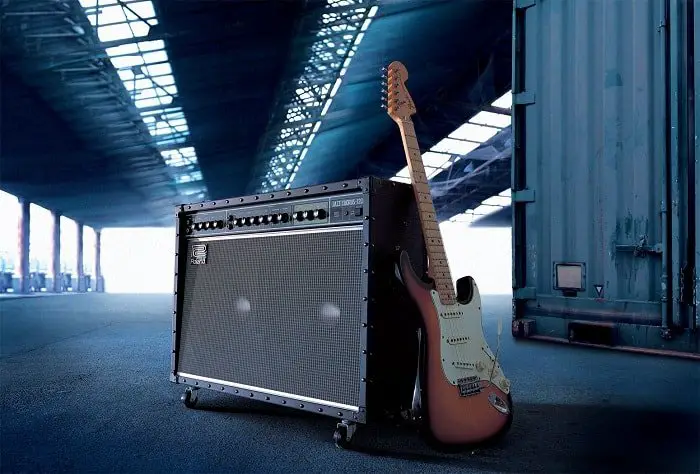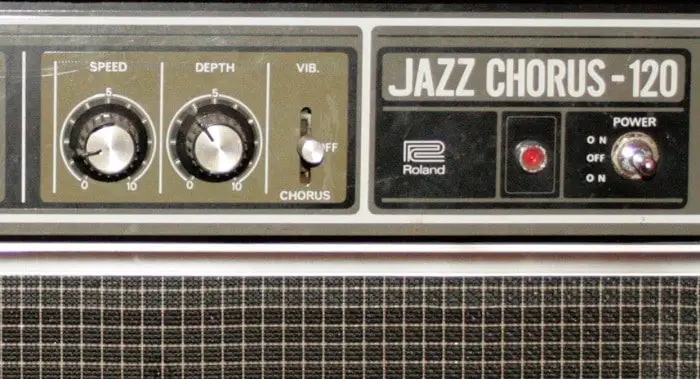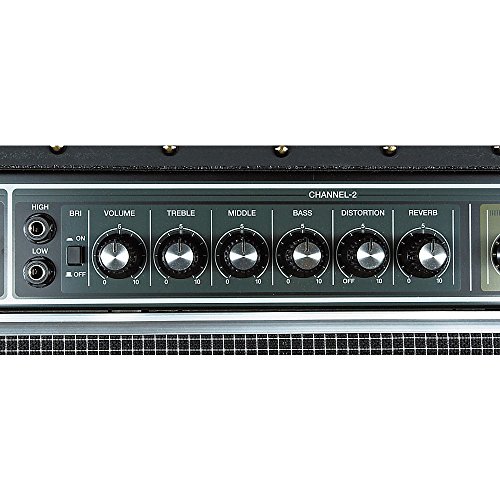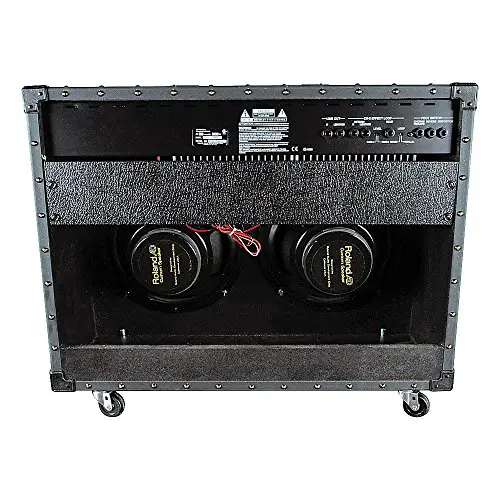
Back in 1975, Roland launched the first JC120 Jazz Chorus amp. There would be nothing too notable about this if it wasn’t one of the earliest solid state amps on the market.
It was also one of the first amps to have a digital chorus section built into the circuitry.
At the time, it was one of the most modern looking amps. However, this ‘modern look’ quickly went out of style leaving Roland with what can only be described as an aesthetic nightmare. Unfortunately this wasn’t it’s only, nor the biggest flaw.
** Check the Price on Amazon **
Just like many other amps, JC120 came with a distortion channel. If there’s a scale that describes the quality of amp’s distortion channel, the one found on JC120 would be on the bottom of the scale. No, it would what you would call the 0 value on that scale of sorrow.
Despite all of this, JC120 Jazz Chorus is one of those amps you simply have to try at least once if you consider yourself a guitar player. By now you are probably wondering how come this is true. There are several reasons for it, which we will cover in depth.
An Overview
Even with all the flaws we mentioned, JC120 Jazz Chorus is still one of the best amps Roland ever made, and they made plenty of them. There is something about its sound and appearance that is hard to describe, and even harder to reproduce.
[su_youtube url=”https://www.youtube.com/watch?v=-bLx30P8wuE”]
Just as a sing of how impressive this box is, we can name you few famous guitar players who swear by this amp. Joe Perry from Aerosmith, Andy Summers and James Hetfield are just some of numerous artists who chose JC120 Jazz Chorus as their favorite.
Features
By modern standards, the design of JC120 Jazz Chorus is not even considered retro anymore. It is by far the biggest flaw of this amp. In simple terms, this is what happens when designers try to imagine what the future would look like, and go a bit overboard with their creation. While it won’t win any beauty contest anytime soon, JC120 Jazz Chorus does feature a very simple and intuitive layout.
The core of this amp is somewhat crude solid state circuit that pushes sound through two 12 inch Roland speakers. They say that it’s a 120 Watt amp, but that is not completely true. JC120 Jazz Chorus actually has two separate power amps rated at 60 Watts each.
Even though it’s not a tube amp, this combo is on the heavy side of things. If you are looking for an amp that you can transport easily, JC120 Jazz Chorus is definitely not it. However, Roland was kind enough to put the whole thing on wheels which definitely helps with this issue.
In terms of controls, things are pretty straight forward. Each channel has its own control cluster with separate inputs. Clean channel, or Channel 1 as it is designated on this amp, comes with volume, treble, middle and bass knobs.
Channel 2, which is supposed to be a distortion channel, comes a distortion knob and reverb knob in addition to the ones we just mentioned. Lastly there is a chorus section which features speed and depth knobs along with a three way switch that allows you to choose a vibrato or chorus effect.
The amp does come with an effects loop thankfully, but it offers no way to connect it to a cab. That is probably even more disappointing than that pure excuse for a distortion channel.
By not giving us any expansion options, Roland has limited the use of this amp to smaller gigs, and some kind of mic’d up configurations that are shady at best.
Performance
Alright, it’s time to talk about the sound of this amp. Before we get to the good part, let us just quickly explain the whole deal regarding the distortion channel on this amp. It is weak, hollow and overall sounds like the cheapest overdrive pedal working at 10% volume and even less gain.
It’s like they accidentally created a semblance of overdrive when they made the amp, and decided to make a whole separate channel just for this unwanted mistake. You’d think that maybe its weak nature would make it a decent blues overdrive, but no, it’s not good enough even for that.
So, it is our kindest recommendation to never ever use the distortion channel on this amp, that is unless you want to be exposed to the most depressing sound ever produced by an amp.
There, now that we got that out of the way, let’s talk about the thing that launched this amp to the stars, its clean channel. When people say clean, they usually mean unaltered guitar signal that is just amplified.
The clean channel on JC120 Jazz Chorus adds a new dimension of clean. In other words, if you think you know what clean guitar channel sounds like and you haven’t head the JC120, the previous statement is false. Simple as that.
 It’s clinical, precise, accurate and unforgiving. Any mistake you make, no matter how small and minute it is, will be amplified and pushed in your face. For some, that is a flaw.
It’s clinical, precise, accurate and unforgiving. Any mistake you make, no matter how small and minute it is, will be amplified and pushed in your face. For some, that is a flaw.
For the majority, it is a virtue that has rarely been seen before or after this amp was released. The chorus is a whole different story of its own. It is something you need to experience in order to understand. As a matter of fact, it is so good that Roland took it out and packed it into a chorus pedal.
What we like
No matter how many flaws we can find on this amp, it is all worth it once you crank it up and hear that crystal clear, surgical clean channel. Add a chorus into the mix, and we are in wonderland.
What we don’t like
That distortion channel needs to be banished back into the darkest depths of hell where it came from. No one should have to suffer through that in their life. That channel, and the overall design of the amps are two main flaws JC120 has.
On the whole
Every feature Roland thought would make the JC120 popular almost ruined it in the end. It was the clean channel and the superb chorus that pulled it out of the gutter and launched to the heights where it now resides.
** Check the Price on Amazon **
If have a chance to get one of these, we strongly suggest you do. There’s nothing quite like it out there.





